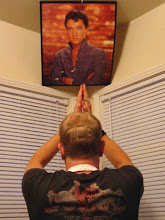One of the greatest bands America's got going for them right now! Hands down! Anyone heard the new one. I haven't. This is them on Letterman recently doing one of the mainly flawless tracks on "Boys and Girls of America."
Thursday, July 31, 2008
Tuesday, July 29, 2008
MTH 212 Paper
Here's something I just wrote on "Proportional Reasoning," for Elementary Mathematics 212.
Proportional Reasoning
The world of ratios is a very different world than that of mere common fractions. I cannot even begin to imagine teaching something as complex as proportionality to a group of fifth graders, after having seemingly just taught them fractions. It almost seems to me that the knowledge of one could almost uproot the knowledge and understanding of the other. Yet, somehow I learned both, even though I have no remembrance of the process. I was educated in Saxon mathematics, which is apparently considered out dated and poor for teaching concrete number sense and deeper understanding of mathematics, by nowadays standards.
I really enjoyed the reviews for the problems in “Proportional Reasoning,” by Jane Lincoln Miller and James T. Fey. I think the most important part of Elementary Mathematics is learning about how kids understand and see a certain problem. If we could actually have kids in the class occasionally to learn from, it would probably be extremely helpful. In the review of Task 2, the children’s responses are very enlightening. One response given is, “Yes, because each drink you buy is 40c cheaper, so you are saving money.” I like this response because it is so simple and correct. The child clearly understands the comparison of the two drinks, but fails to comprehend the quantity inherit in the values. This is a common mistake by children, whereas more is usually better, meaning the Gatorade would probably be chosen if the question was not phrased “most economical choice.” This of course brings me to my next discussion, which is the poor word choice, “most economical choice,” as you can see one kid didn’t have any idea what that even meant. As I’m sure several students here at PCC Cascade would struggle with that in a math class, without any background whatsoever in economics.
In Task 1, the problem deals with very concrete ratios. We are not working with any total values. Yet, we have to deal with ratios or direct comparison, which represent the relationship between two numbers. It is difficult to recognize a greater relationship than simple addition, the idea of something being directly proportionate is a much higher complex understanding. Children and adults alike tend to think that if an amount is increased by another amount, the other amount given must be increased by that same amount. It is often they do not see the direct proportional rate that needs to be applied to both given amounts. A given amount that has been doubled, must apply that same doubling to the other given amount. Doubling the number 4, takes you to 16, an increase of 12. Yet if we are given a second amount of 3, and simply add 12, as opposed to doubling 3, we get 15, which is very different from 9. The relationship between 4:3 and 16:9 is directly proportionate. The relationship between 4:3 and 16:15 is just not in any way. Proportionately represents a greater understanding of fractions, percents, multiplication and the beginning of exponents. Task 3 is a great problem because enlarging a picture is a concrete real world activity expressing a direct proportionality between the two sides of the photo. I would think it would be the most concrete hands-on activity for a classroom to develop into their curricula.
Proportional Reasoning
The world of ratios is a very different world than that of mere common fractions. I cannot even begin to imagine teaching something as complex as proportionality to a group of fifth graders, after having seemingly just taught them fractions. It almost seems to me that the knowledge of one could almost uproot the knowledge and understanding of the other. Yet, somehow I learned both, even though I have no remembrance of the process. I was educated in Saxon mathematics, which is apparently considered out dated and poor for teaching concrete number sense and deeper understanding of mathematics, by nowadays standards.
I really enjoyed the reviews for the problems in “Proportional Reasoning,” by Jane Lincoln Miller and James T. Fey. I think the most important part of Elementary Mathematics is learning about how kids understand and see a certain problem. If we could actually have kids in the class occasionally to learn from, it would probably be extremely helpful. In the review of Task 2, the children’s responses are very enlightening. One response given is, “Yes, because each drink you buy is 40c cheaper, so you are saving money.” I like this response because it is so simple and correct. The child clearly understands the comparison of the two drinks, but fails to comprehend the quantity inherit in the values. This is a common mistake by children, whereas more is usually better, meaning the Gatorade would probably be chosen if the question was not phrased “most economical choice.” This of course brings me to my next discussion, which is the poor word choice, “most economical choice,” as you can see one kid didn’t have any idea what that even meant. As I’m sure several students here at PCC Cascade would struggle with that in a math class, without any background whatsoever in economics.
In Task 1, the problem deals with very concrete ratios. We are not working with any total values. Yet, we have to deal with ratios or direct comparison, which represent the relationship between two numbers. It is difficult to recognize a greater relationship than simple addition, the idea of something being directly proportionate is a much higher complex understanding. Children and adults alike tend to think that if an amount is increased by another amount, the other amount given must be increased by that same amount. It is often they do not see the direct proportional rate that needs to be applied to both given amounts. A given amount that has been doubled, must apply that same doubling to the other given amount. Doubling the number 4, takes you to 16, an increase of 12. Yet if we are given a second amount of 3, and simply add 12, as opposed to doubling 3, we get 15, which is very different from 9. The relationship between 4:3 and 16:9 is directly proportionate. The relationship between 4:3 and 16:15 is just not in any way. Proportionately represents a greater understanding of fractions, percents, multiplication and the beginning of exponents. Task 3 is a great problem because enlarging a picture is a concrete real world activity expressing a direct proportionality between the two sides of the photo. I would think it would be the most concrete hands-on activity for a classroom to develop into their curricula.
Monday, July 21, 2008
Biggest Movie Ever

A movie review? What the heck is up with this blog...where are all the downloadable music files and album reviews. So, I haven't gotten around to them, please just bare with me. For now, its more or less a lot about my boring life and the things I want to comment on or care about or that happen to me. So, I saw Dark Knight by my lonesome, like the rest of America, and was quite impressed. I think the main reason I wanted to see it though, was for Heath Ledger. I wanted to see this final performance that is already garnering oscar reviews. Seeing the film reminded me of the feeling I had about The Crow and Brandon Lee's mysterious death. In fact the role even was similar. Did Heath lose his shit and go into a full depression by becoming this maniacal villian? My answer is that it surely had a lot to do with it. The role is psychotic to say the least and the character is easily the most entertaining part of the flick. I'm curious as to what affect this movie is going to have on America. It's not a movie for kids. Its twisted. The other important question is: Is it better than the very first Batman, the one with the Prince soundtrack. (I can remember getting it on tape. It sucked. Poor introduction to Prince.) Nicholson 's joker has a lot of humor, but not Ledger, its all twisted and sick humor. The weird thing though is that it got a lot of laughs during the movie. We are all just getting sicker and sicker as human beings. I just don't know. At the same time, I admittedly really wanted to see this movie, to see Heath Ledger's final performance. Which I am sure is adding to the record breaking weekend gross for this film. ARe celebrities going to start dieing off to break box office records. Well, if so...can I suggest Tom Cruise.
On a side note, I would like to point out that if depression or some kind of psychosis had anything to do with Ledger's death, I would surely point the finger first as his friendship with the soul-less Olson twins, who is rumored to have "rolled with."
Friday, July 18, 2008
Web 2.0
This is DEFINITELY worth watching and very relevant to my little cyber world that is this silly blog.
Thursday, July 17, 2008
July 4th
Alley @ Laughing Planet
Animation
My roomate made this with his girlfriend. It took him a lot of hours. I have no idea how long, but well over a week....
Headphones
It's impressive and makes me realize how much I not only need a new computer but also how much I need to take some computer savy classes at PCC. Or something.
Headphones
It's impressive and makes me realize how much I not only need a new computer but also how much I need to take some computer savy classes at PCC. Or something.
Wednesday, July 16, 2008
Tuesday, July 15, 2008
Sunday, July 13, 2008
Ukiah, CA
I'm sure anyone looking at this know that I grew up in Ukiah. I'm sure most of those people know there's also a Doobie Broothers song in homage to Ukiah called, "Ukiah." Well...the other day I stumbled across this home made video on youtube to go along with it. It's pretty bad but fairly appropriate. I haven't blogged in a while. Sorry to my thousands of readers our there. I know you've been holding your breathe in anticipation.
Subscribe to:
Comments (Atom)













